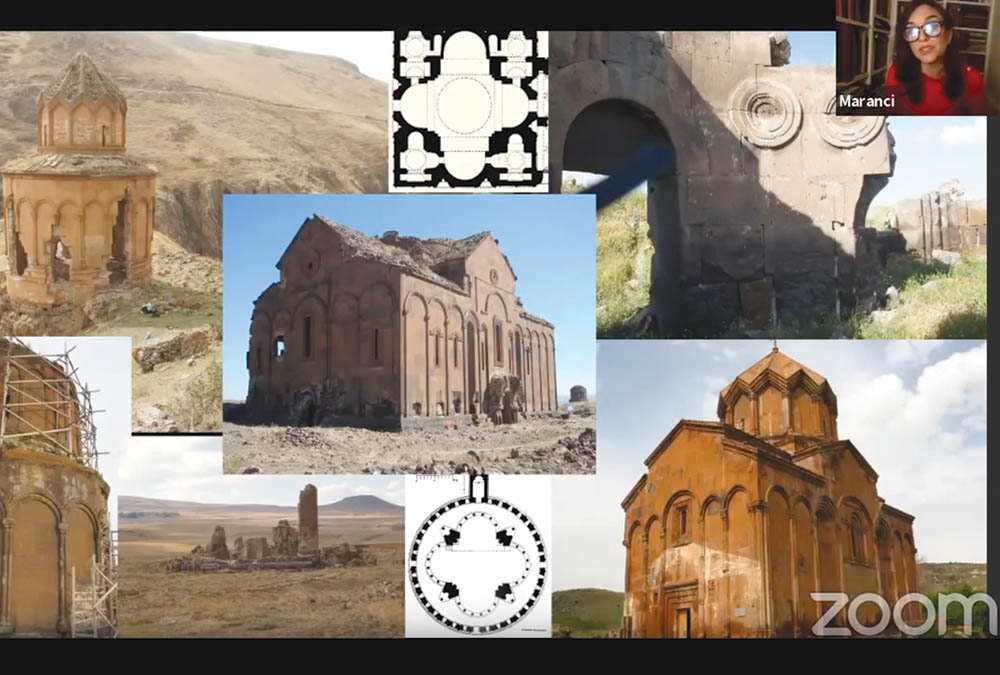
Sosse Ann Baloian
Staff Writer
The Armenian Studies Program kicked off its first Zoom lecture in the Armenian Studies Program Fall Lecture Series on Thursday, September 3, 2020 by welcoming Dr. Christina Maranci to discuss her artistic interpretations of the Cathedral of Ani, in a talk entitled “Ani Cathedral, Its Sculpture, and Its Inscriptions Revisited.” Dr. Maranci acknowledged that her research is ongoing and she encouraged students to “be curious because you never know what you are going to find.” She stressed the importance of gathering historical, contextual information before diving into the art of the church itself.
Dr. Maranci is the Arthur H. Dadian and Ara Oztemel Professor of Armenian Art and Architecture and Chair of the Department of Art History at Tufts University.
Dr. Maranci has published myriad articles and essays on Armenian art including, The Art of Armenia: A Critical Art History of Ancient and Medieval Armenia, with a concluding chapter on cultural heritage (New York and London: Oxford University Press, 2018) and Vigilant Powers: Three Churches of Early Medieval Armenia (Turnhout: Brepols, 2015).
Dr. Maranci is currently writing a new book that will include Ani Cathedral in comparison with other early church architecture.
For Dr. Maranci, the Cathedral of Ani is a “carefully faceted geometric form.” The intricacy and attention to detail is quite remarkable to witness up close. Dr. Maranci stated that the blind arcades create a “visual rhythm” on the exterior. She also mentioned that the interior apse provides a sense of height unlike other church architecture during this period.
Dr. Maranci considers the Ani Cathedral an important, influential work of Armenian and medieval architecture set in the context of a larger architectural movement or tradition that arises during the reign of the Bagratid Empire (10th-11th centuries).
By examining the potential attitudes towards images and material things, Dr. Maranci analyzes the architecture almost like a book.
After all, architecture is made up of more than justwalls, piers, and vaults. Dr. Maranci highlighted the importance of inscriptions, sculpture, wall painting, written texts, and archaeology discovered at the Cathedral of Ani.
Inscriptions convey more than a record of dates and people. They are able to reveal social relations and theological positions during the time period.
According to Dr. Maranci, there are about six synchronistic dates that can be identified on the Ani Cathedral: Armenian era, Era of the Romans, Islamic era (Hijri date), Creation, Year of Incarnation of Christ, Year of Christianization of Armenia, Reigns of King Gagik and Catholicos Sargis. You can read the translated inscription below and interpret it for yourself:
“In the year 450 of the Armenians and 219 of the Romans […], in the time of the divinely-honoured and spiritual Lord Sargis, Catholicos of the Armenians and the glorious kingship of Gagik Shahnshah of the Armenians and the Georgians,
I, Katranidē, Queen of the Armenians, sister of Vasak, King of Siwnik’, took refuge in the mercy of God, upon the order of my husband, Gagik Shahansha, I built this holy Cathedral which was founded by the great Smbat, and we erected a house of God, a new and living spiritual offspring, and an everlasting monument. I adorned it also with precious ornaments, gifts from me to Christ and also [from] my clan and sons Smbat, Abas, and Ashot.
I, Lord Sargis, have ordered the servants of the church, after the passing of the worshipful queen, to celebrate at the Fast of Transfiguration with forty masses unceasingly until the coming of Christ; And if anyone neglects this inscription let him be condemned by Christ. In 6: 1000: 500: 30: and 3 from Adam; 1000: 2 10: of the incarnation of God: and 718 since the conversion to Christ of the Armenians this memorial was written by the hands of Benē.”
Ani Cathedral is described as “a new and living spiritual offspring, an everlasting monument.” (Նորոգ եւ կենդանի ծնունդ հոգեւոր եւ արձան մշտնջենաւոր)։
Although this monument has been in an area of potential risk, the intent of this church is to serve as a continuous symbol of new life.
 Hye Sharzhoom Armenian Action
Hye Sharzhoom Armenian Action